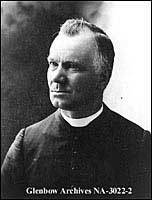
For almost 110 years, there has been a bronze marker in the Priest Lot with the name “Cornelius Scollen” embossed on it. A recent e-mail from Ian Fletcher, an English historian, corrected a long standing mistake and gave a few clues to interesting details of Father Constantine Scollen’s work and life. Apparently when Father Scollen retired to St Elizabeth’s Hospital, he was known to the Dayton community as “Father Con”. Whoever signed his death certificate guessed at his Christian name as well as his birthdate.
Father Constantine Scollen (4 April 1841 – 8 November 1902) was an Irish Roman Catholic missionary who lived among and evangelized the Blackfoot, Cree and Métis peoples on the Canadian Prairies and in Montana. Later he worked among the native peoples of the USA on missions in what is now North Dakota, Wyoming, Nebraska and Kansas. In 1870, he had spent the winter at Rocky Mountain House, co-writing a Cree language grammar and dictionary with his mentor, fellow Oblate and friend, Albert Lacombe.
In 1876 he was an interpreter for some of the Plains Cree Chiefs and witness to Treaty 6 between the Cree and the Canadian government. He was a consultant to the Canadian government prior to the signing of Treaty 7 with the Blackfoot Confederacy, in 1877 and was also an interpreter and witness. He also wrote a book of 75 sermons in Cree, for Fr Dupin. In 1883, he wrote an unpublished Blackfoot/French dictionary and grammar for Fathers Doucet and Legal and to Fr Lacombe he gave a grammar, catechism and some hymns, in Blackfoot, all written and composed by him. Being a capable violinist, he also wrote the music.
In Wyoming in 1892, he created an Arapaho alphabet and orology. It was possibly the first example of a written form of the language. His original notebook is in the Smithsonian Institution, Washington DC. He had an extraordinary talent for languages and became the foremost linguist in the Oblates of Mary Immaculate, in Canada.
In addition to his bi-lingual childhood tongues of Erse (Irish) and English he was fluent in Greek, Latin, French, Italian, German and the First Nation languages/dialects of Cree, Blackfoot, Peigan (North and South) Stoney, Ojibwe, Sarcee and Arapaho. (Most of these native languages belong to the Algonquin family) He taught English to his fellow missionaries (who were all native French speakers) and First Nation languages to new arrivals. He was the only native English speaking Oblate priest among his exclusively French and French Canadian fellow priests and was the first priest to live among the Blackfoot. Scollen’s intervention with Chief Crowfoot of the Blackfoot Confederacy in 1879 and again with Chief Bobtail of the Cree in 1885 resulted in the avoidance of bloodshed.
The second mystery relates to the whereabouts of Father Scollen’s 250 page ,unpublished autobiography, “Thirty Years Experience Among the Indians of the Northwest.” Upon his death, the manuscript went to Father Siebenfoercher, a former parish priest who retired to Dayton and died in 1911. The St Mary’s Seminary of Cincinnati has his other papers, but not Scollen’s manuscript. A genealogical enquiry is being conducted to find Siebenfoercher relatives who may have it and not know its value.

